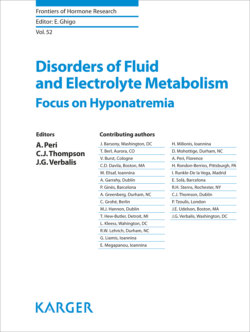Читать книгу Disorders of Fluid and Electrolyte Metabolism - Группа авторов - Страница 29
На сайте Литреса книга снята с продажи.
Mechanisms of Urinary Concentration
ОглавлениеKokko and Rector, as reviewed by Sands and Kokko [16], have proposed a model of urinary concentration that is in concert with the anatomic features and the permeability characteristics of the various segments of the system, while limiting the active transport of solute to TALLH in the outer medulla. The components of the mechanism, are:
1. The water-impermeable TALLH actively cotransports sodium, chloride, and potassium, thereby increasing the tonicity of the surrounding interstitium and delivering hypotonic fluid to the DCT. Urea is poorly reabsorbed and therefore retained in the tubule.
2. Under the influence of vasopressin in the cortical and outer medullary CDs, tubular fluid equilibrates with the isotonic and hypertonic interstitium, respectively. Low urea permeability in this portion of the nephron allows its concentration to further increase.
3. In the presence of vasopressin, the inner medullary CD is rendered more permeable to urea. Therefore, in this segment of nephron, in addition to water reabsorption, urea is reabsorbed as it diffuses passively along its concentration gradient into the interstitium, where it constitutes a significant component of the medullary interstitial tonicity.
4. The resulting increase in interstitial tonicity creates the osmotic gradient that abstracts water from a highly water permeable and solute impermeable tDL. This process elevates the concentration of sodium chloride in the tubular fluid. When tubular fluid reaches the bend of the loop, its tonicity is the same as that of the surrounding interstitium. However, the sodium chloride concentration of the tubular fluid is higher and the urea concentration lower than that of the interstitium.
5. Tubular fluid then enters the tAL, which is more permeable to sodium than urea. The sodium gradient provides for passive removal of sodium chloride from this segment into the interstitium.
To prevent urea removal from the inner medulla to the cortex, the ascending and descending vasa recta act as a countercurrent exchanger and “trap” urea in the inner medulla. The ascending vasa recta may also deposit urea into adjacent tDL of a short loop of Henle, thereby recycling it to the inner medullary CD. The short loops of tDL do not enter the inner medulla; thus, the addition of urea to these loops does not interfere with the removal of water from the tDL in the inner medulla, a step that is so crucial to the concentrating process.
This passive model of urinary concentration has a number of attractive features, and many of its aspects have been experimentally supported [16]. However, the requisite difference in sodium and urea permeability that is needed for this model to operate passively (point 5 above) have not been met, as mathematical models that employ available permeability fail to generate the desired osmotic gradients. Thus, alternatives have been tested. Among these, a three-dimensional reconstruction of the components of the rat inner medulla coupled with the development of mathematical models has emerged with a variation of the previous model, designated as solute mixing passive model [17]. This model recognizes that the water permeability of the tDL does not extend into the inner medulla, as AQP1 is absent in the lower half of this limb of the loop of Henle. The high urea permeability and the passive exit of sodium from tubular fluid occur before the bend of the loop, equally in the thin descending as well as ascending loops rather than exclusively in the latter. While this model predicts the generation of a concentrated urine, it does not produce one that is maximally concentrated [17].
What remains widely agreed upon is that the single effect in the TALLH, so critical to the operation of the countercurrent system and urinary concentration, also serves to dilute the urine. In the absence of vasopressin, and thus with water impermeability of the CDs, the continued reabsorption of solute in the remainder of the distal nephron results in a maximally dilute urine (50 mOsm/kg). Thus, it should be apparent that impairment of sodium, chloride, and potassium cotransport in the TALLH would limit the renal capacity both to concentrate and to dilute the urine.
Fig 1. a Homeostatic response to free water deficit. b Homeostatic response to free water excess. OVLT, organum vasculosum of lamina terminalis; PVN, paraventricular nucleus; SON, supraoptic nucleus.
